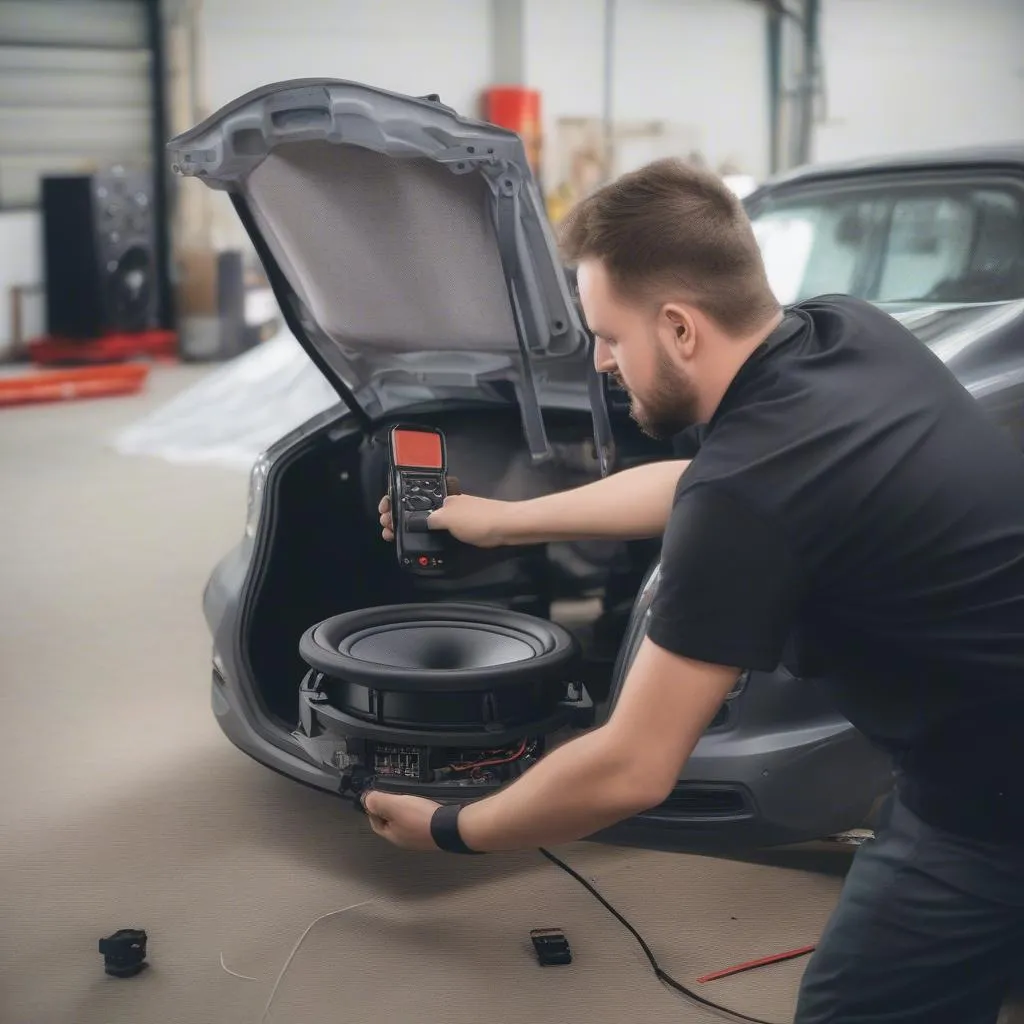Imagine cruising down the highway with your favorite tunes blasting, but then, silence. No music, no podcasts, just the hum of the engine. A broken car speaker can be a real buzzkill, literally. But don’t worry, understanding how car speakers work and what to look for in a replacement can help you get your tunes back in no time!
Understanding the “Loud Speaker” in Your Car
The term “loud speaker” is often used colloquially to refer to the speakers in your car. However, it’s helpful to break down what these speakers actually are and why they’re important. Let’s dive into the world of car audio:
What is a Car Speaker?
A car speaker is an electro-acoustic transducer that converts electrical signals from your car’s audio system into sound waves. This process happens through a complex interplay of components:
- Magnet: Creates a magnetic field that interacts with the voice coil.
- Voice Coil: Attached to the cone and suspended within the magnetic field.
- Cone: A diaphragm that vibrates to produce sound waves.
- Surround: Holds the cone and allows it to move freely.
- Spider: Supports the voice coil and helps it move back and forth.
When an electrical signal passes through the voice coil, it interacts with the magnetic field, causing the cone to vibrate. The faster the signal, the faster the vibrations, and the higher the pitch of the sound. This is how you hear the different frequencies of music and other sounds.
Types of Car Speakers
Car speakers come in various shapes and sizes, and are often categorized by their frequency range:
- Woofers: These are typically larger speakers designed to handle low frequencies (bass).
- Mid-range speakers: Handle the mid-range frequencies, producing the sounds of human voices and instruments.
- Tweeters: These small speakers are designed for high frequencies, like the crispness of cymbals or the high notes of a violin.
Why Car Speakers Matter
Good quality speakers can enhance your driving experience in several ways:
- Sound Quality: Enjoy a clearer, more detailed and enjoyable listening experience.
- Immersion: Feel the music, hear the nuances of vocals, and create an immersive audio environment within your vehicle.
- Safety: Clear audio allows you to hear navigation directions, warnings, and other important sounds.
Choosing the Right Car Speaker
Now that you understand the basics of car speakers, you can make an informed decision about your next purchase. Here are some factors to consider:
Size and Fit
Car speakers come in different sizes, so measure the diameter of your existing speakers to ensure you get a compatible replacement. Common sizes include:
- 4-inch
- 5.25-inch
- 6.5-inch
- 8-inch
Impedance
Impedance is a measure of resistance to electrical flow. It’s important to choose speakers with an impedance that matches your car’s audio system. Most car audio systems have an impedance of 4 ohms.
Power Handling
This refers to the amount of power a speaker can handle without distortion. Higher power handling generally translates to louder sound, but it’s important to choose speakers that are within the power capabilities of your car’s audio system.
Frequency Response
This indicates the range of frequencies a speaker can reproduce. Look for speakers with a wide frequency response for the most accurate and detailed sound.
Sensitivity
Sensitivity measures how efficiently a speaker converts electrical energy into sound. A higher sensitivity rating means the speaker can produce louder sound at a lower power input.
Common Questions About Car Speakers
Q: Can I replace my car speakers myself?
A: Yes, you can. There are plenty of tutorials and videos online that can guide you through the process. However, if you’re not comfortable with DIY projects, it’s always best to take your car to a professional.
Q: What are some popular brands of car speakers?
A: Some well-known car speaker brands include:
- Alpine
- JL Audio
- Kicker
- Rockford Fosgate
- Pioneer
Q: How do I know if my car speakers are blown?
A: Signs of blown car speakers include:
- Distorted sound: The sound may be muffled, scratchy, or crackling.
- No sound: One or more speakers may not produce any sound at all.
- Burning smell: You may smell burning coming from the speakers.
Q: What is the difference between coaxial and component speakers?
A: Coaxial speakers have all the speaker drivers (woofer, midrange, tweeter) integrated into a single unit. Component speakers separate the tweeter from the woofer, allowing for better sound staging and accuracy.
Q: How do I choose the right speakers for my car?
A: It depends on your budget, your audio preferences, and the type of car you have. If you want the best sound, consider component speakers with a wide frequency response and high sensitivity. If you’re on a tighter budget, coaxial speakers can still deliver decent sound quality.
Conclusion
Car speakers are a crucial part of your vehicle’s audio system, contributing to both enjoyment and safety. Understanding the basics of car speakers, the factors to consider when choosing a replacement, and common questions can help you make an informed decision. If you’re still unsure, feel free to contact us! We have experts who can help you select the perfect speakers for your car and even assist with the installation.
Remember, the journey is the destination, and with the right music, every drive can be an adventure.
 car speaker system
car speaker system
 car speaker installation
car speaker installation
 types of car speakers
types of car speakers
To ensure you have the best possible listening experience, reach out to us on WhatsApp: +84767531508. Our team of experts is available 24/7 to answer your questions and provide support!


